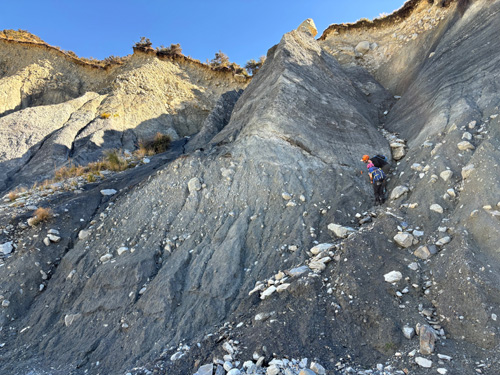1 May 2024–Friction along a fault during an earthquake can sometimes generate a rise in temperatures high enough to produce a signal in the organic and mineral material contained within the fault’s rocks.
At the Seismological Society of America (SSA)’s 2024 Annual Meeting, Genevieve Coffey of GNS Science discussed how she and her colleagues are using biomarkers as high-temperature proxies for faults in New Zealand and California. Their research has yielded new insights into the history of earthquakes along those faults and how frictional energy might contribute to the overall energy budget of earthquakes.
One of the biomarkers that Coffey and colleagues work with is methylphenanthrenes, hydrocarbons that form during the transformation of organic material in sedimentary rock. The abundance of thermally stable versions of the biomarker increases as temperature in the rock increases, offering a way to look at both temperatures and the duration of heating that signal the occurrence of a past earthquake.
“The central section of the San Andreas Fault is believed to be creeping and not capable of nucleating large earthquakes, but our biomarker work has shown that it has hosted large earthquakes – larger than magnitude 6 – in the past,” said Coffey. “Our past work in New Zealand on the Pāpaku Fault, which is a splay fault that branches off the Hikurangi Subduction Zone, shows that it too has hosted large earthquakes.”

The researchers have paired biomarkers with potassium-argon dating to take a closer look at faults along the southeastern part of New Zealand’s North Island, in a study funded by the Royal Society of New Zealand. “Using these techniques on bedrock faults on our target faults in New Zealand has allowed us to validate that these faults have hosted earthquake slip in the past, but far back enough in time that they can be considered as inactive,” Coffey said.
Along with biomarkers, geologists use other thermal proxies including the presence of a rock called pseudotachylyte, vitrinite reflection and calcite decomposition, all of which capture the high temperatures caused by the shearing and friction along a rupturing fault. These proxies capture temperatures on the order of 100s to higher than 1000 degrees Celsius, or more than 500 degrees Celsius in the case of the biomarkers, Coffey said.

High temperature signals “provide us a tool to identify where coseismic slip has occurred, which can be useful to map out what parts of a fault have ruptured and specifically within what structures or layers slip has localized,” she explained.
Temperature rise can also help research understand whether a fault is slipping as the result of earthquakes or creep, Coffey noted.
She and her colleagues have compiled data on biomarkers and other thermal proxies to take a closer look at how the frictional energy captured by the proxies is related to an earthquake’s overall energy budget. Their results so far suggest that there are “key differences in how energy is partitioned between small and large earthquakes, where the earthquake energy budget of small earthquakes is dominated by frictional energy, while for large earthquakes the energy budget is more evenly split between frictional, radiated and fracture energy,” Coffey said.
